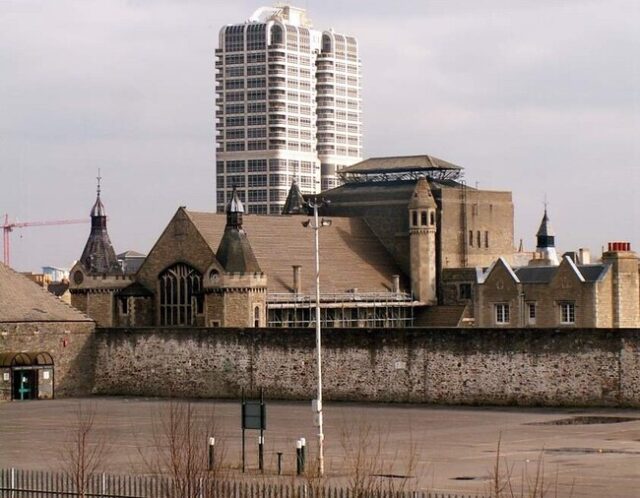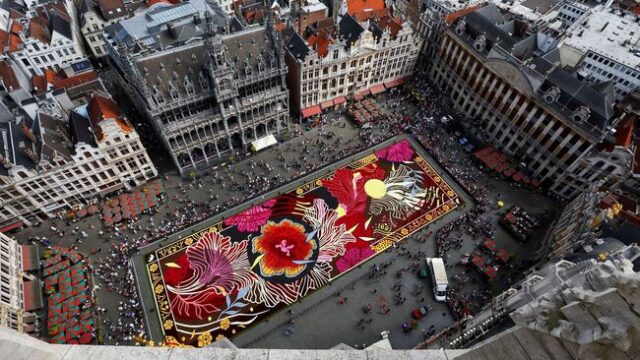
In August 2024, Brussels again dazzled tourists and locals with its biannual flower carpet tradition, covering the Grand Place with a stunning display of colorful blooms. The 2024 edition, designed by visual artist Océane Cornille, was a breathtaking spectacle spanning 1,680 square meters (18,083.37 square feet), filled with begonias, dahlias, grass, and bark. The intricate design, which took over six hours and a hundred volunteers to assemble, showcased the delicate beauty of nature against the backdrop of the city’s historical architecture. Cornille’s vision transformed the square into a temporary garden, with a vibrant sound and light show illuminating the carpet each evening, adding another layer of magic to the already captivating scene.
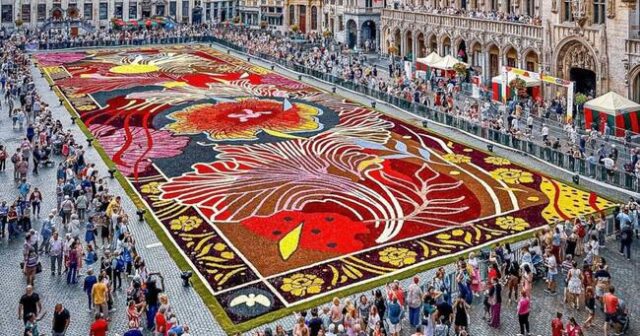
Cornille’s design for this year’s flower carpet was inspired by the rhizomatic nature of Brussels, symbolizing the interconnectedness of the city’s neighborhoods through organic forms and vibrant colors. The iris, the city’s emblem, took center stage in the design, representing Brussels’ resilience and historical strength. Cornille described the piece as an invitation to reflect on urban life, diversity, and the fleeting beauty of such a transient work of art. Though the flower carpet only adorned the Grand Place for three days, from August 15, it left a lasting impression, highlighting the harmony between nature and city life in one of Europe’s most beautiful squares. Fans of Cornille’s work can continue to follow her creative journey through her Instagram account.
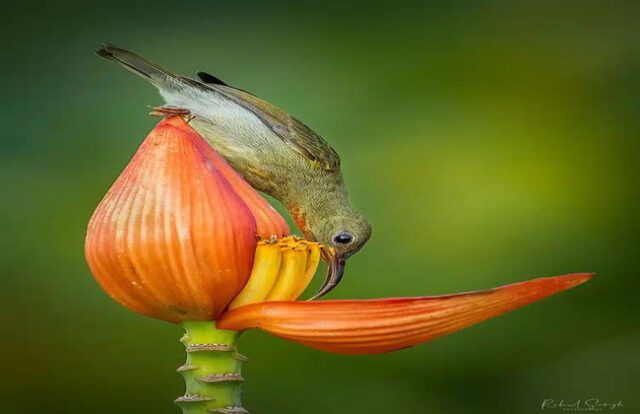
Award-winning photographer Rahul Singh has captured an extraordinary moment in nature, where a tiny female Crimson Sunbird is seen bathing in the petal of a banana flower. This remarkable scene, set in Jalpaiguri, India, shows how small creatures, like the 10 cm long Sunbird, interact with their environment in unique ways. The banana flower petal acts as a natural basin, collecting just enough water for the bird to take a refreshing bath. On hot, humid autumn Continue reading “Photographer Captures a Tiny Crimson Sunbird Bathing in a Banana Flower Petal Pool” »

Wall-mounted animal lamps by Uncle Lucas Studio bring a touch of the wild indoors, merging nature and art in unique, playful ways. Inspired by a variety of animals, these lamps are more than just functional lighting; they are statement pieces that evoke the outdoors. Crafted with incredible attention to detail using 3D printing technology, these designs include a range of animals, from fierce alligators to friendly Siamese cats. The realism of their design is striking, with lifelike features like fur, scales, and even teeth meticulously rendered. These pieces are a perfect fusion of craftsmanship and nature-inspired decor, providing a delightful way for people to connect with the natural world inside their homes.
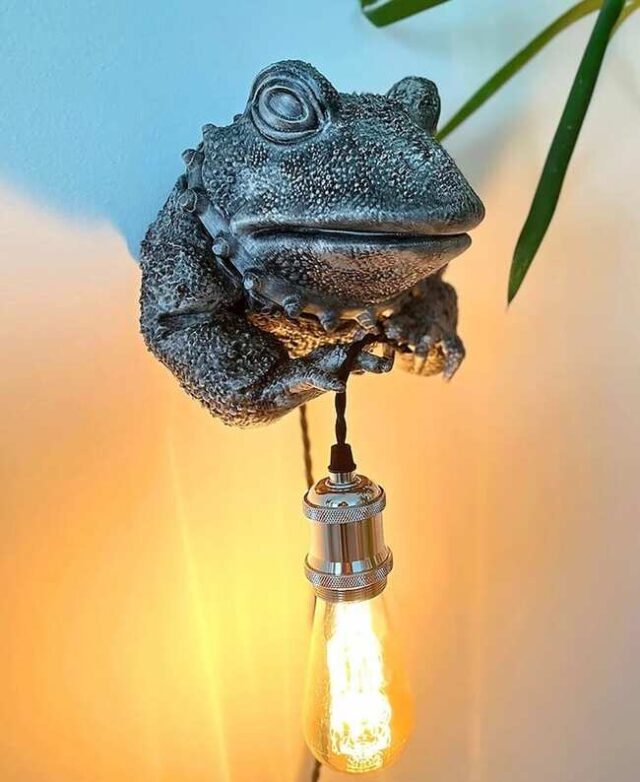
What sets these animal lamps apart is the whimsical way they blend lifelike accuracy with a dash of surrealism. Each animal is depicted holding the cord or light bulb in its paws or mouth, creating a sense of interaction with the environment. This playful design adds personality to any space, whether you opt for the classic tones of gold, silver, or white. Available on Etsy, the lamps come with customization options for plug-in or hardwired installation, allowing you to adapt them to your interior needs. These quirky yet elegant pieces add a unique charm, making them perfect for those who want to infuse their home decor with wild creativity.

Francis Apraku, a custodian at James Madison High School in Vienna, Virginia, had a simple dream of owning a Jeep Wrangler. Known for his kindness and positive spirit, he had become a beloved figure among the students. When some freshmen learned that Apraku, who had immigrated to the U.S. from Ghana, wished for the car as a birthday gift, they were determined to make it a reality. Although they couldn’t act immediately, the students spent the next six months planning. They launched a GoFundMe campaign, contacting friends, family, and local organizations to raise funds. By the beginning of September, they had gathered $20,000 to buy a cherry red 2015 Jeep Wrangler from a local dealership.

When Apraku was surprised with his dream car at the school, his reaction was emotional. Overwhelmed by the gesture, he dropped to the ground, expressing disbelief and gratitude. “I don’t believe this would happen in my life,” he said, thanking God for the moment. The students were equally excited, knowing they had made a difference for someone who always uplifted them. “He puts a smile on everyone’s face daily,” said student Hunter McGee. The heartwarming gesture not only showcased the students’ generosity but also highlighted the powerful bond they shared with a man who had become much more than just a custodian.


LEGO has set an ambitious goal to make 50% of its bricks from renewable materials by 2026, as part of its broader mission to create more sustainable products. Currently, 78% of LEGO’s plastic is still sourced from fossil fuels, but the company is actively working to reduce this dependency. Through its mass balance tracing method, LEGO can track how much of its plastic comes from sustainable sources. The company has already tested over 600 alternative materials, Continue reading “LEGO Aims to Make Half Its Plastic Renewable by 2026” »
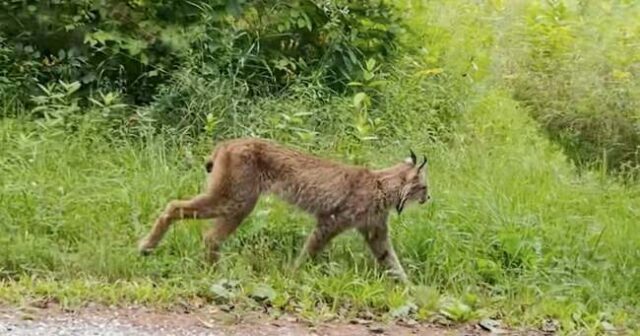
Gary Shattuck, a Vermont resident, had an extraordinary encounter while driving through central Vermont when he spotted what he initially thought was an odd-looking bobcat. Intrigued, Shattuck recorded the animal and sent the footage to Vermont Fish & Wildlife for identification. Much to his surprise, the agency confirmed that he had stumbled upon a rare Canada lynx—an elusive species not seen in Vermont since 2018. This sighting Continue reading “Vermont Man Stumbles Upon Elusive Canada Lynx in State’s First Sighting Since 2018” »
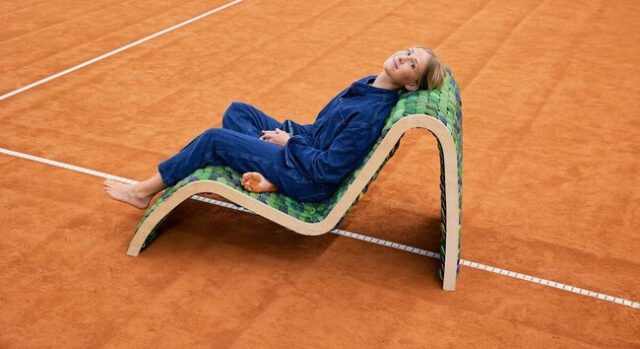
Belgian eco-designer Mathilde Wittock is tackling the massive waste problem posed by discarded tennis balls by transforming them into bespoke furniture pieces. With around 300 million tennis balls manufactured annually, most of which end up in landfills and take 400 years to decompose, Wittock’s innovative approach offers a circular solution. Her team can hand-carve up to 1,800 balls a day, using them as micro-cushioning elements for stylish and comfortable furniture, such as chaise lounges and benches. These pieces, with tennis ball fuzz dyed to match interior design schemes, take about 2-3 weeks to complete, adding a touch of eco-friendly sophistication to any space.
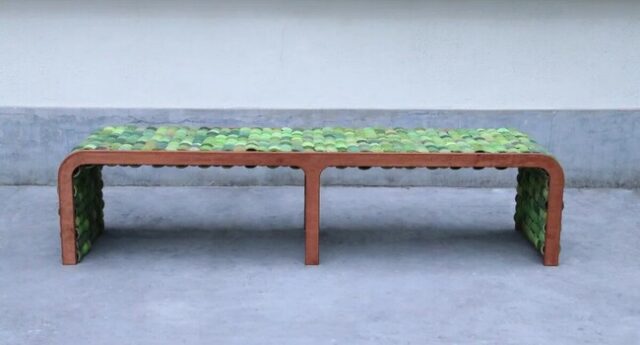
Wittock’s venture highlights the importance of circularity in eco-design, as she seeks to give discarded tennis balls a second life. By receiving large donations of used tennis balls from sports organizations, such as the Federation of Wallonia, Wittock can sustainably source her materials and produce furniture for months. Once the lifespan of her furniture ends, Wittock ensures the pieces remain eco-friendly by repurposing the rubber shells into bouncy play mats for children. This approach ensures that even the waste from her products can be reused, making her designs sustainable and minimizing their environmental impact.
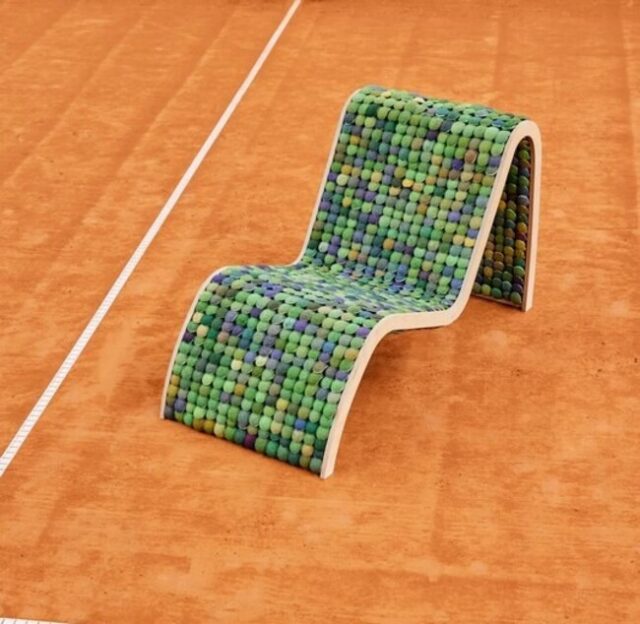

Two years ago, Alabama’s Abbie Rutledge had an unexpected encounter that would change her life forever. While driving to work, she was pulled over for speeding by state trooper J.T. Brown. Filled with anxiety, she worried about how she would pay for a ticket, especially since she felt stuck in a dead-end job. Instead of giving her a citation, Trooper Brown took the time to sit and talk with her about her career options. Their 10- to 15-minute conversation became a turning point, as Brown encouraged Rutledge to consider pursuing nursing school. Inspired by the officer’s advice, Rutledge leaped, enrolling in nursing school shortly afterward.

Fast forward two years and Rutledge is now a surgical technician at the University of Alabama Hospital, grateful for the career path she’s chosen. She credits Trooper Brown for his life-changing advice and even invited him to her graduation to celebrate the achievement together. Brown was astonished to see how their brief conversation had such a lasting impact, and Rutledge still cherishes the original citation marked with a $0.00 fine and Brown’s handwritten message urging her to pursue her dreams. This touching story highlights the transformative power of kindness and how one small act of empathy can inspire real change in someone’s life.

The historic Swindon Railway Village in lower England, once a dangerous “no-go area,” has been transformed into a thriving heritage neighborhood through a major restoration project. Initially established between 1841 and 1842 by the Great Western Railway (GWR), under the direction of Isambard Kingdom Brunel, the village housed workers who labored at what was then one of the world’s largest railway engineering complexes. The area boasted pioneering amenities, such as the UK’s first modern public library and a healthcare center that inspired the National Health Service. Over time, as the railway works became obsolete, the village fell into decline, becoming unsafe for residents and visitors. However, the Swindon Heritage Action Zone (HAZ), launched in 2019, sought to reverse this decline with an ambitious five-year plan aimed at restoring the village to its former glory.

Through a partnership between Historic England, Swindon Borough Council, and other organizations, over 300 historic buildings in the area were refurbished, including the iconic Swindon Works, the Mechanics Institute, and the health center. The restoration not only preserved the area’s rich industrial heritage but also created new opportunities for local businesses and cultural initiatives. Streets were returned to their original dimensions, parks were rejuvenated with flowers and trees, and plaques were installed to highlight the history of the village. The Carriage Works, an 11-unit building where train carriages were once repaired, was revitalized with modern renovations and now houses both businesses and the Royal Agricultural University’s Cultural Heritage Institute. These efforts have breathed new life into the area, ensuring the 150-year legacy as a center of railway engineering and community innovation is not forgotten.

